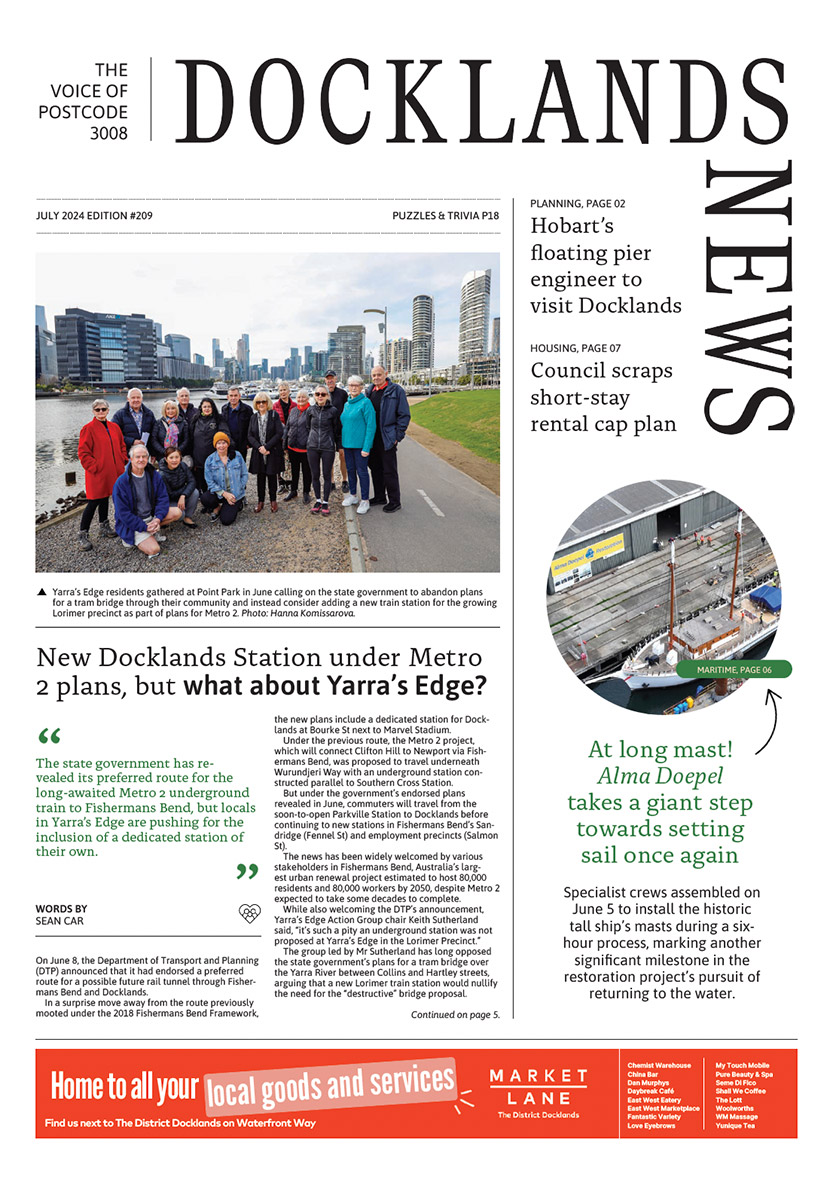Wharf life
By Ashley Smith - Royal Historical Society of Victoria
Dated around 1924, this photograph reflects a time in Victoria Dock when workers didn’t rely on powerful electrical or motorised machines to unload cargo from overseas or interstate.
This photograph is likely to be taken at the Dudley St end (or the north end) of the dock, as evidenced by the building with the chimney in the background. This was the Sands and McDougall factory building at 355 Spencer St, built in the late 1880s and remaining the company’s factory and office until the 1970s. Sands and McDougall was a stationery company best known for its annual street directory, which indexed the ever-changing streetscapes of Melbourne and its suburbs from 1857 until 1974. Today the directories are used heavily by historians as a research tool. Sands and McDougall also owned a box factory a stone’s throw away at Adderley St, last recorded by the directory in 1928. Fortunately, the Spencer St factory remains standing and is now used as a training centre.
As for dock life during this period, it was anything but uneventful. In 1924 around 1.3 million tonnes of cargo were handled at Victoria Dock. For the wharfies in Victoria’s ports, no job was permanent and it was every man for themselves. To be picked, labourers had to go through the daily “bull pickup” system, where workers gathered at a pick-up site and the employer would determine who would work based on who appeared the strongest or most capable. If you didn’t pass, you would either go home or look elsewhere for work.
Even if one survived selection, there were further perils. As the photograph shows, much of the work was manual as pullies, slings, carts and just brute strength were used to haul cargo
on or off ships and into storage. With these la- bour-intensive duties, accidents were bound to happen. Newspapers would highlight worker accidents, with goods falling from slings causing anything from fractured legs to paralysis and death. Sometimes fires would break out, destroying valuable goods, as reported in The Age in 1922 (January 30) when 70 bales of paper meant for the government printer combusted at a shed in Central Pier. Among all of these dangers, workers also had to deal with intense heat and long work hours.
Sometimes work timeframes could blow out, causing problems for the ships and dock congestion. A 1919 article from The Age (March 21) noted that due to limited unloading space and full sheds, the steamer Australia had to visit three sheds and then “tranship 400 tons of goods into a lighter” to empty out its 10,000 tonnes of cargo. A 1924 report in The Argus (October 21), pointed out that “As many as 23 vessels have been accommodated in the port at one time, and each one has discharged or loaded heavy cargoes.” To alleviate congestion, extra sheds were built at Berths 16 and 17 in 1920 (left hand side of photograph) followed by an extra cargo shed north-west of the dock in 1926. This was the longest structure in the dock at almost 1300 feet (or 400 metres).
During the 1920s, life for a wharfie (in Victoria and interstate) became rougher. In 1928, the judge for the Commonwealth Court of Conciliation and Arbitration, George Stephenson Beeby, introduced an award for waterside workers. It included double pick- ups, freezing the rate of pay for wharf workers (and cut out overtime pay), lifting restrictions on shift hours to hasten the turn-around of ships, and ignoring cries for improved safety regulations. Disgusted with the new condi- tions and wages, the workers (especially those tied with unions) from Victoria and multiple states went on strike, with wharf employers relying on non-union and volunteer labour. Among the chaos, Prime Minister Stanley Bruce’s Transport Workers Act went through
Parliament in September 1928. Also known as the “Dog Collar Act” it allowed the federal government to control who worked on the docks and wharves of Australia, with workers needing to pay one shilling a year for eligibility.
In the weeks of strikes that followed, there were many acts of violence. Multiple homes of volunteers and their families were bombed, and strikers crowded around Customs House to attack any willing volunteers who bought their licences (some of which included migrants from Italy, Greece and Czechoslovakia). On November 2, days after Beeby further restricted unionist rights by only allowing them 40 per cent of all wharf work, around 700 to 2000 waterside workers (the numbers varying between newspapers) stormed Princes Pier in Port Melbourne to attack the volunteers. In a heated confrontation with police, the authori- ties were forced to use their guns, injuring four of the rioters. Tragically, one of them was Alan Whittaker, who died two months later from complications caused by his head and neck wounds. When the strikes folded, the workers returned to draconian conditions and pittance wages, which were further compounded when the Depression struck.
Today Victoria Dock is a far cry from those tough days. The sheds of the north end have been torn down, and replaced by upmarket restaurants and high rises of NewQuay Promenade. However, the sight of boats parked along the edge of the quay, even if built for lei- sure rather than cargo, are still a common sight that reminds us of the past •

New Docklands Station under Metro 2 plans, but what about Yarra’s Edge?





 Download the Latest Edition
Download the Latest Edition